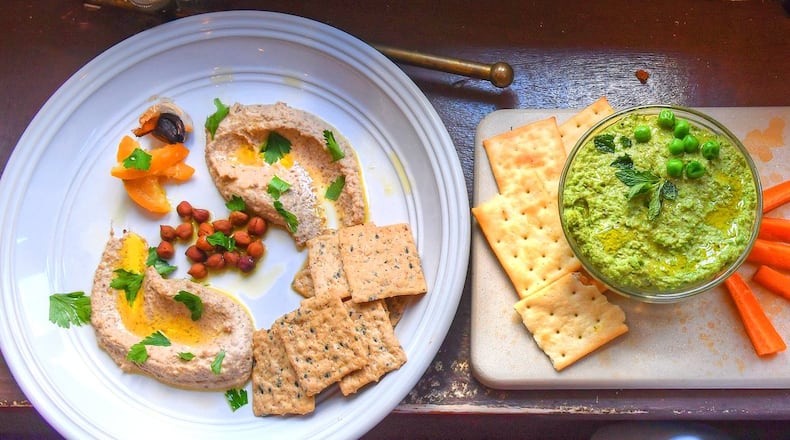Jason Hill toyed with the idea of putting hummus on Wisteria’s menu as he was preparing to open his popular Inman Park restaurant nearly 20 years ago.
“The girl I was dating loved hummus, and I used to make it for her at home,” he remembers. He saw its potential as a shareable starter. But he wasn’t sure how the Middle Eastern mainstay would fit with the restaurant’s refined Southern theme. So he tried swapping black-eyed peas for the chickpeas, and replacing the pita with sweet potato chips, pickled okra spears, and other house-brined local vegetables. Black-Eyed Pea Hummus remains a signature appetizer to this day.
That was before hummus became a grocery staple. Sabra, the Israeli dip company, joined forces with PepsiCo in 2008 and flooded supermarkets with plastic tubs filled with pre-made hummus in flavors from classic to sun-dried tomato to “taco inspired.” Sales skyrocketed, farmers raced to plant more chickpeas, and competitors jostled their way into refrigerator cases with their own versions.
High in protein and fiber with a mild, creamy taste that’s easy to digest and offends no one, hummus is that rare food that accommodates virtually every demographic and special diet: kid-friendly, nut-free, gluten-free, lactose-intolerant, vegan, kosher.
Even the store-bought stuff is good for you and welcome to have around for snacking by even the most discerning gourmet. Still, there’s no match for the velvety-smooth handmade hummus served in restaurants like the Olive Bistro, the Mediterranean stalwart with locations in Midtown and Vinings; and Aziza, the modern Israeli restaurant on Atlanta’s Westside.
It’s not hard to make at home. And there’s no better time to give it a try than while holed up as we ride out the coronavirus pandemic. All you need is a pot, a food processor or high-powered blender, and a few inexpensive staples. I was already up to my elbows in hummus experiments just as the city began shutting down, and I’ve found the process a calming distraction and the results gratifying.
For the most basic hummus, I followed the instructions by the New York chef Einat Admony in her 2019 homage to her roots: “Shuk: From Market to Table, the Heart of Israeli Home Cooking” (Artisan, $35). I made batches of Wisteria’s Black-Eyed Pea Hummus, along with other creative versions that caught my eye in the latest crop of cookbooks: one with roasted beets topped with the spiced nut and seed topping called dukkah; one with frozen peas and sunflower seed butter; and one with black chickpeas and preserved lemons that aroused my curiosity enough to order the main ingredients online.
I’ve eaten them as a snack with pita and carrot sticks, and as an entree topped with spiced ground lamb as is customary in the Middle East. I’ve packed up extras to hand to neighbors while keeping our social distance.
We’ve included those recipes.
And if all you’ve got is a plastic tub of the pre-made stuff?
Take a tip from Joe Yonan, food editor of The Washington Post, author of the cookbook “Cool Beans,” and self-described hummu-phile:
“Take it out of the fridge and bring it to room temperature, or microwave it a few seconds to take the chill off. Whisk in a little water so it’s not so sludgy, swoosh it in the center of a plate, and drizzle it with some good olive oil. It will taste so much better.”
>> RELATED: AJC's review of "Cool Beans"
Perfectly Balanced Hummus
In “Shuk: From Market to Table, the Heart of Israeli Home Cooking” (Artisan, $35), Einat Admony writes that the key to achieving smooth, silky hummus is to simmer the soaked dried chickpeas with a little baking soda to help soften them. Some serious hummus buffs insist on skimming off the chickpea skins for an even airier texture, but others don’t bother, claiming it weakens the flavor and removes nutrients. Your choice. If you’re short on time, start with 5 cups of canned, drained chickpeas and proceed as directed.
Classic Tahini Sauce
Drizzle this creamy, tangy sauce over hummus or roasted vegetables. Sauce will keep several days in the refrigerator, but garlic should be added fresh to order. Excerpted from “Shuk” by Einat Admony and Janna Gur (Artisan Books, $35).
Wisteria’s Black-Eyed Pea Hummus
Chef-owner Jason Hill of Wisteria gives hummus a Southern twist by substituting black-eyed peas for chickpeas and pairing it with homegrown flavors. You can soak the peas overnight to shave off a little time, but it’s not necessary.
Black Chickpea Hummus with Black Garlic and Preserved Lemon
Joe Yonan includes an assortment of hummus recipes in “Cool Beans” (Ten Speed, $30). I was most intrigued by this one calling for black kabuli chickpeas, which he says have a super-nutty flavor and deep black color that turns brown as it cooks. He adds that black chickpeas sold as ceci neri in Italian specialty stores can also be used, as can the lighter-colored, smaller ones sold as kala chana in Indian stores, which I found at Patel Brothers supermarket in Decatur. Slightly sweet, umami-rich black garlic and tart, salty preserved lemon add extra elements of intrigue. I ordered both online — if you’ve never used them, they’re fun ingredients to play with in a multitude of recipes you’ll find in a Google search. As a vegetarian, Yonan likes to turn this into a main dish by swooshing it on a platter and topping it with roasted cauliflower seasoned with sumac.
Spiced Lamb Hummus
In the Middle East, hummus often becomes a main dish by topping it with a spiced meat mixture, usually beef or lamb. Tieghan Gerard offers her own quick and delicious take in “Half Baked Harvest: Super Simple” (Potter, $29.99).
Sweet Pea and Sun Butter Hummus
This simple hummus tastes of spring, with frozen peas standing in for chickpeas and sunflower seed butter (found in natural foods sections) for the tahini. It’s a great way to get kids to eat their peas. It’s from Lauren Angelucci McDuffie’s “Smoke, Roots, Mountain, Harvest” (Chronicle, $29.95).
Beet Hummus
This magenta-hued hummus from Susan Spungen’s just-published “Open Table” (Avery, $35) is a dazzler in color and taste. She infuses canned chickpeas with extra flavor by roasting them together with fresh beets and garlic, then adds fresh garlic to the final blend. Dukkah — the fragrant nut and spice mixture that follows — takes it over the top.
Hazelnut-Pistachio Dukkah
This savory nut and spice mixture adds a jolt of flavor and crunch to practically anything. If you can’t find hazelnuts, almonds will do the trick. This is also from “Open Kitchen” by Susan Spungen (Avery, $35).
RELATED:
Read more stories like this by liking Atlanta Restaurant Scene on Facebook, following @ATLDiningNews on Twitter and @ajcdining on Instagram.
About the Author
Keep Reading
The Latest
Featured









